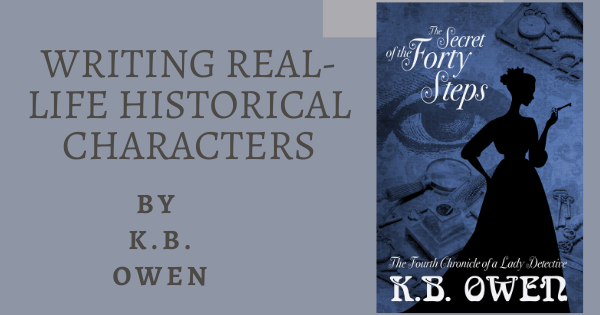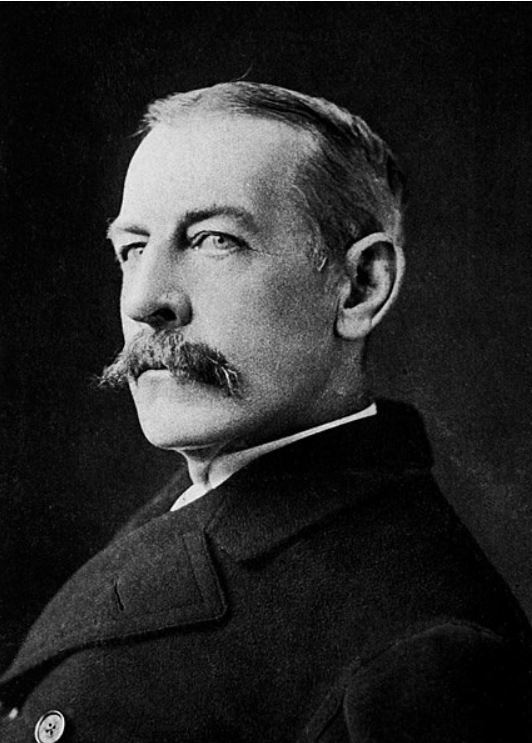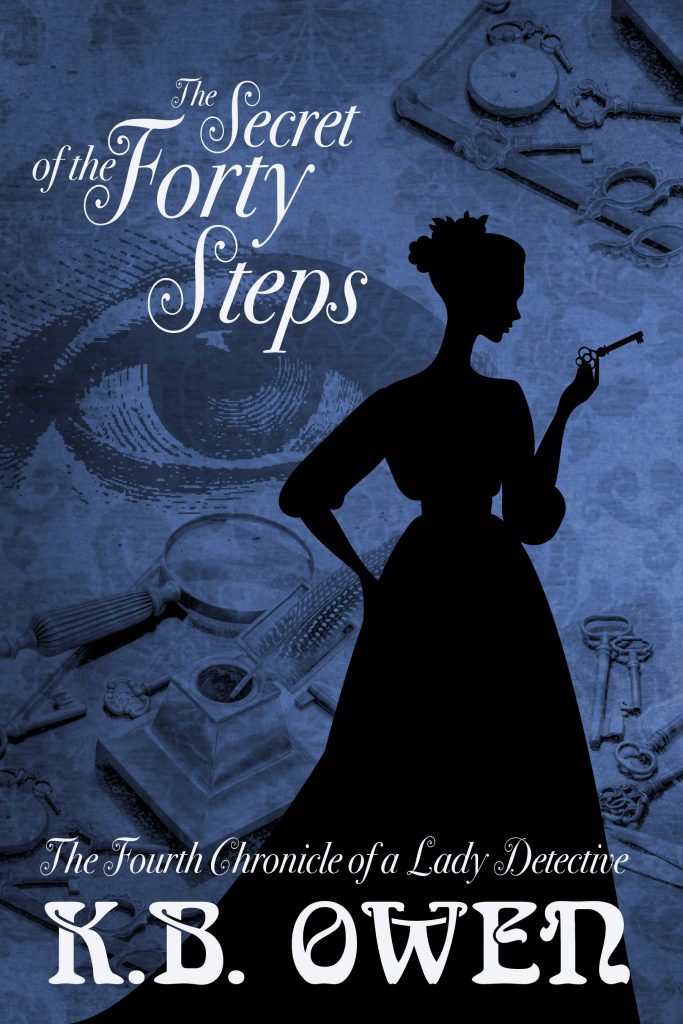
By K.B. Owen, @ kbowenwriter
Have you ever thought about adding a famous historical figure to your story? After all, it’s been done successfully by the likes of Stephanie Barron, Anne Perry, Sue Wittig Albert, Shelley Noble, Margaret Frazier, and many others. What’s not to love about seeing kings, dukes, inventors, famous authors, musicians, movie stars—the list goes on—come to life on the page?
But, to paraphrase Jeff Goldblum’s character in Jurassic Park, just because you can, doesn’t mean you should. There are a few downsides. For one thing, it involves more extensive research—combing through diaries, letters, newspaper accounts, and more. Also, you’ll want to be careful in your portrayals of historical figures. There could be descendants who might object to you characterizing beloved great-great-great-Uncle Henry as, say, a philanderer (even if true). Nobody wants a libel suit.
But let’s assume, for the purposes of this post, that you want to take the plunge. I say…go for it! The possibilities are exciting, and in my opinion the end result is worth the extra work. Here are my tips for making it easier.
First, decide in advance what kind of time you want to put into research, and adjust your character’s involvement accordingly. In my lady Pinkerton series, the historical figure of William Pinkerton, my protagonist’s boss, is an important stepping stone to her getting a case. I use him sparingly, however. He’s more of a launching point to provide context for the story, so I only needed to research some basics about him, and a bit more regarding Pinkerton detective procedure.
Major characters require more in-depth research, however, which brings me to the importance of…
Choosing someone who’s the right fit. The first instinct for many authors is to be guided solely by the famous person’s significance to the story’s historical moment. That’s a major requirement, sure, but I consider two additional factors: 1) what background information I can find, and 2) their personality, especially in the context of my protagonist (for those looking to write the historical figure as the protagonist, well…that’s a whole different post).
Let me illustrate with two figures I used recently. In THE CASE OF THE RUNAWAY GIRL (a story set in early 1887), I wanted a backdrop that plunged my female detective in a “fish out of water” situation. I settled on the old-boy backroom politics of late-19th century Washington, DC, a place rife with ruthless industrial tycoons who greased a lot of palms to get what they wanted. High stakes, and definitely a challenging environment for my lady Pinkerton to navigate.
Moving on to my historical figure…I chose an Illinois senator, Shelby Moore Cullom. By all accounts he was a man of integrity dealing with a broken system, and yet managed to get the Interstate Commerce Act (ICA) signed into law.

Many other people had been involved in the passage of the ICA, and I consider several alternative figures. What finally sealed the deal for me was finding Cullom’s extensive memoir, Fifty Years of Service, which included speeches and great insider details. I ended up mining it for turns of phrase and snatches of overheard arguments (my sleuth listens at doors, of course!).
On the other hand, my decision to use newspaper magnate James Gordon Bennett in my new release, THE SECRET OF THE FORTY STEPS, was based mostly on his personality. He’d summered in Newport (the setting I’d decided upon) during the crucial time period, so I’d cleared my first requirement. In terms of personality, he was a writer’s dream come true—powerful, excessively wealthy, shrewd in business, a flamboyant spender, and an avid sportsman who played polo, tennis, and raced yachts. Real-life accounts of him were fiction gold—his drunken faux-pas (once, while inebriated, he urinated in the fireplace…some say it was the piano…in front of his soon-to-be-ex-fiancee’s family), his crazy wagers (he dared his friend to ride his polo pony through the Newport Reading Room, which of course he did), and his hedonistic lifestyle (a dairy cow was kept in a special stall on his yacht so he’d have fresh milk and butter every day when cruising at sea).

Such a personality as Bennett’s provided a great foil for my protagonist. As the other characters fawned over this Colossus of upper-class society, my lady detective—not awed, which annoyed him no end—had to maneuver around the impediments he tossed in her path. She even managed to put him in his place a few times. (I hope folks get as much of a kick out of reading those parts as I did in writing them. *wink*).
There are, of course, other ways to go about incorporating historical figures—every author’s process is different. These are the basics that work for me. I hope they’ll be helpful for you, too!
Have you thought about using a figure from history in your story? What factors would you consider in making your choices? I’d love to hear your thoughts.
Happy writing,
Kathy
Website: https://kbowenmysteries.com
Facebook: /kbowenwriter2
Twitter: @kbowenwriter
Instagram: @kbowen_mysteries
THE SECRET OF THE FORTY STEPS

The fourth chronicle of a lady detective
Money, love, and murder in 1880s Newport high society…
Pinkerton detective Penelope Hamilton is summoned to fashionable Newport to investigate the two-year-old death of a wealthy matron. Did she fall from the Cliff Walk’s Forty Steps in the middle of the night, as was presumed, or was she pushed by her much-younger husband?
The case is personal this time, since Pen’s client is her own mother—breaking her near-decade of silence—and the man under scrutiny is to marry Pen’s cousin in a week’s time.
The lady detective discreetly enlists the help of a local, but the inquiry quickly unravels when he turns up dead. To make things worse, Pen’s identity as a Pinkerton is uncovered by Newport’s most prominent summer resident, whose complaint to her boss brings Pen’s estranged husband and fellow Pinkerton, Frank Wynch, to Newport.
With her cousin’s wedding day nearly here and no answers yet, Pen has no choice but to accept Frank’s help while dodging his romantic overtures. Nothing like a little danger to heighten an already-fraught relationship, as they work to expose a desperate adversary…who could prove deadly to them both.
Available at these online retailers:
Tips for Writing Real-Life Historical Characters by @kbowenwriter : Share on X
Thanks so much for this great post, Kathy! I especially like your advice on choosing a historical figure who’s the right fit for the story. It would be easier to choose one that we knew more about, but the choice might not work as well for the book.
You did pick quite the character to include in your story. Unless I shoot Napoleon into space and across time, I probably won’t be adding them to my stories.
I don’t know, Alex…sounds intriguing, LOL! I’d pay to read that. *wink*
It would take a lot of research but certainly add realism to a story.
Great post! I wouldn’t have thought of approaching choosing the historical figure that way – but it makes sense. Great advice!
Thanks, Jemi! It took a bit of trial and error to get at what process works for me, LOL.
Thanks so much for having me here, Elizabeth! You have a great community of writers here at the water cooler. ;)
Absolutely delighted to see Kathy Owen here! And such good advice about writing historical characters. I have to admit, I haven’t tried that yet, but I do notice the difference between real-life characters who are woven in effectively, and those who…aren’t. Thanks for the advice!
Aww, Margot, you’re sweet – thanks! I really enjoy reading about real historical figures – that are done well, as you say.
Great tips, Kathy! And your post is giving me story ideas. I wonder if my protagonist could dig up some real mystery from the past and try to solve it. Hmmm…
An intriguing idea, Kass! I look forward to seeing you run with that one!
There is a thing called biographical historical fiction which some of us write. Yes, I have certainly written not merely about but from the point of view of historical personages.
By the way, the estate or relatives of a dead person cannot sue for libel over defamatory statements made about the dead person. On the other hand, if the family is very influential, they could probably make life uncomfortable or even hurt sales.
Yes, it doesn’t have to be a lawsuit to be an unpleasant process. Also, a well-loved figure that readers have an attachment to and may not be as agreeable as they think…that could lead to some push back as well.
I’ve had two short stories published in which the sleuth was a real person. Weegee was a famous crime photographer in New York City in the 1930s and early 1940s (some of work hangs in museums), and with my interest in photography, he was the perfect fit for me. He was fun to write.
Sounds perfect, Bruce! And a really interesting mystery angle, if you’ll pardon the pun. *wink*